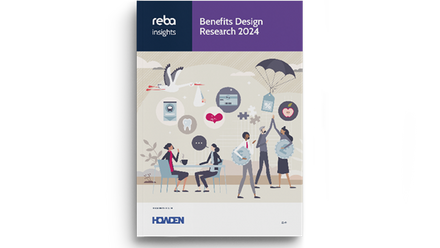Why employers need to fine-tune benefits packages to boost engagement and productivity

The research, based on a survey of 2,000 private sector employees in the UK, focused on employee attitudes to their financial situation, and segmented respondents into four categories:
- those who were unworried
- those with future worries (those worried about their ability to afford retirement)
- those withcurrent worries (those with concerns about their finances in the short-term but who feel confident of being able to afford retirement)
- the struggling, who have both short and long-term concerns.
The link to productivity
Although individual’s perceptions of their financial wellbeing has improved over the last few years, 20% of those surveyed felt that financial worries were having a negative impact on their lives: one in four have concerns about debt, and one in three are worried about their current financial state.
Strong links to poor health and time off work were also evident, with the Struggling cohort, reporting nearly seven days lost due to absence compared to three days on average for those who are Unworried. Some 78% of the Struggling group are experiencing high or above average levels of stress (compared to 32% for the Unworried group), and less than a quarter report they are in very good health (compared to over a half for the Unworried group).
Employees with money troubles also report themselves the least engaged (most disengaged) at work and admit that money worries are affecting their job performance (59% of those with Current Worries and 39% of the Struggling segment say money concerns prevent them from performing at their best at work).
“Financial issues affect business results by their impact on employee productivity, resulting in greater stress and absenteeism and acting as a distraction to employees engaging with their work” says Jonathan Gardner, senior economist at Willis Towers Watson.
How can employers respond?
Employees with the most pressing financial concerns were also less satisfied with their pay and benefits and more likely to seek to a broader benefit offering. Almost three in five would like to be offered some alternative to pay and bonus.
Nevertheless, suggestions that Generation Y place no value on pensions are found to be wide of the mark. Retirement benefits continue to be viewed as very valuable, with one in three willing to sacrifice pay and bonus in exchange for superior retirement or health benefits. Given an allowance to spend on a variety of benefits, the Unworried group said they would spend 48% on retirement savings and even the Current Worries would allocate 34%.
“Employees feel vulnerable, desire retirement security and are willing to pay for it. Retirement benefits remain at the core of the desired benefits package for all groups. The problem is that although younger people are happy to save for their retirement, they often have other priorities and face other demands on their cash such as student debt and saving for a house” explains Minh Tran, senior DC consultant at Willis Towers Watson.
One straightforward measure to help win over younger employees would be to divert some of the pension budget to a savings plan (e.g. corporate ISA) to help them save to pay down debt or accrue a deposit for a mortgage.
“But it shouldn’t be viewed as a zero-sum game where helping workers save for the here and now crowds out saving for retirement. Helping employees pay down debt is another way of building trust and ultimately easing them into saving for retirement” says Tran.
Benefits reset?
“With all the changes to pensions tax relief and allowances, the shift from DB to DC, and changes in the world of work, existing benefits programmes may no longer be fit-for-purpose and able to meet employee needs in the 21st century,” he says.
“Employers need to question their role. First and foremost, they must ask what is the employee benefits budget designed to do and who is it designed to help? What does it do for different age cohorts and is that the employer’s desired outcome? Employers are already responsible for long-term savings. Therefore, is it so very different to move into broader wealth creation? There will be better outcomes if employees can be encouraged into better financial behaviour. It is not necessarily about spending more but using the Budget to address the needs of different groups.”
Whilst the last 20 years has seen globalisation and technology transform many industries, for the most part benefits packages look largely the same. Most employers have not moved far from offering a standard package of health and retirement benefits, life cover and a limited set of other benefits. It will frequently represent a legacy of different products that have been bolted on at different times.
“But this is slowly changing. Our research points to growing interest amongst employers in developing a broader financial well-being strategy, with over 70% having implemented a plan or considering one in the next few years1” adds Tran.
Financial wellbeing – are employees ‘on-board’ for a broader employer role?
Whilst money concerns ensure employees are a receptive audience on financial issues, there are mixed views on what the role of the employer should be. Most are positive towards employers assisting workers to save for retirement, but are more uncertain on the idea of employers taking an active role in encouraging their employees to better manage their finances. Many are uncomfortable when it comes to the question of whether the employer should send targeted information to employees who are not saving enough. (46% disagreed it is the role of an employer to do so).
“There is undoubtedly an opening for a broader set of financial benefits to better meet employee needs, but for many employers developing broader workplace savings packages is a move into largely uncharted territory and a step beyond their current role,” says Gardner. “We may need to challenge employee perceptions. There are clearly sensitivities about personal financial issues and employees may be reluctant to be nudged without trust being built first. Workplace savings initiatives then need to be built slowly to start with.”
Helping employees to help themselves
While all employers are required to operate pension schemes as a result of auto-enrolment, many offer more than the minimum contributions, and it can be cost neutral to divert some of this.
To illustrate how saving opportunities can be lost, take one large nationwide UK retailer with a large proportion of employees of whom are young, transient and aspiring first home buyers. The employer pays pension contributions of up to 15% of salary into the workplace pension scheme on a double matching basis, but there is hardly any take up of the employers’ maximum matching contribution structure among younger employees. The retailer has instead allow employees the option to redirect some of the pension funding into a corporate ISA, reducing their need to get involved with the administration as it would be deducted directly from payroll and taking advantage of preferential corporate rates.
Connecting to employees and enabling choice
In practice, we know that an employer can’t just launch a benefits package with a plethora of choices and expect high levels of activity. Employees desire the flexibility choice provides, but are demotivated by choice overload.
How can employers square this contradiction and motivate employees to help themselves?
- Use segmentation to identify differences in employee needs and target solution to meet those needs
- Use personalisation to ensure communications resonate with employees and their personal circumstances
- Provide tailored choice architecture to help employees navigate the array of choice they face – much can be achieved with apps and online tools so employees are not overwhelmed by choice and are pushed along a decision tree.
In terms of harnessing technology, HR and benefits arguably lag other industries. Employees, however, have been quick to adopt financial apps and online tools in their private lives. Up to 60% use mobile apps to monitor banking accounts and pay bills while up to 51% visit online price comparison sites to shop around for the best deals. Up to 41% manage and track savings and investments online and 40% have budgeting tools to help monitor their household spending.
Summary
Employers are increasing consider broadening their benefits offering to facilitate broader savings goals. This is an opportunity for employers to fundamentally reassess whether their existing employee benefit programme is fit-for-purpose, given the changing work, tax and pensions environment. Budgets can be reshaped so benefits packages are better able to help employees’ different financial priorities, from the short to medium term savings, through to the traditional long term retirement savings.
Needless to say, any shift of employer focus from ‘retirement savings’ to ‘wealth creation’ will mark a major departure. Trust will need to be built and personalised and targeted communications may help employees to engage in new programmes and enable them to take advantage of the wider range of choices offered.
This article was provided by Willis Towers Watson.
In partnership with WTW
WTW is a leading global advisory, broking and solutions company.







